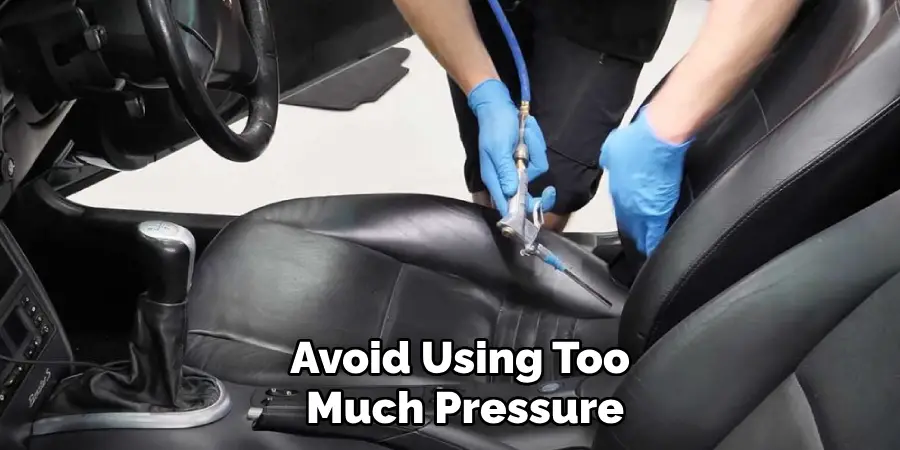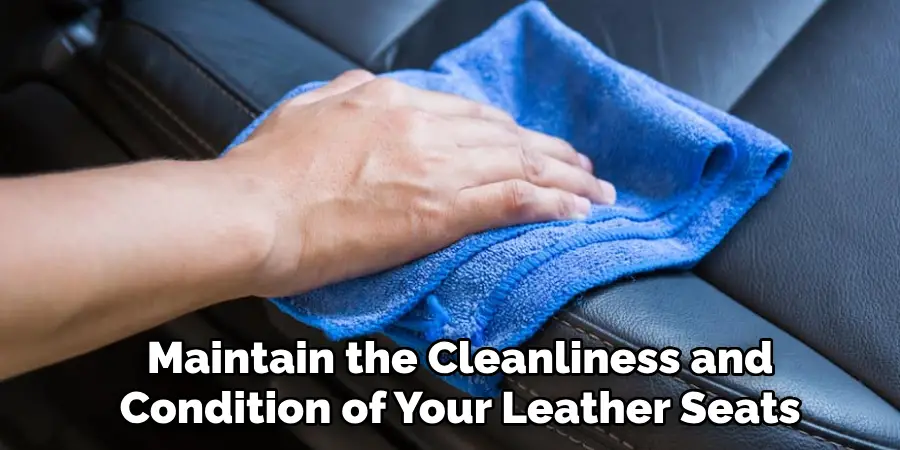Maintaining leather seats in your car is essential for preserving their luxurious appearance and ensuring their longevity. Leather, being a natural material, requires special care and attention to prevent it from cracking, fading, or becoming discolored over time. Regular cleaning, conditioning, and protection from the elements can keep your leather seats looking pristine.

By investing a little time in their upkeep, you can enhance the aesthetic and resale value of your vehicle while enjoying the comfort and elegance that leather seats provide. In this guide on how to take care of leather seats in a car, we’ll explore effective strategies and tips on how to properly care for your car’s leather seats.
Why is It Important to Take Care of Leather Seats?
Leather is a porous material that can easily absorb moisture, oils, and dirt. If left untreated or not properly maintained, these substances can cause irreversible damage to the leather seats in your car.
For instance, excess moisture can lead to mold and mildew growth, while oils and dirt can cause discoloration and deterioration of the leather over time. Furthermore, exposure to heat and UV rays can also cause fading and cracking of the leather.
Proper maintenance and care not only prevent damage but also extend the lifespan of your leather seats. This helps you save money in the long run as replacing or repairing damaged seats can be costly. Additionally, well-maintained leather seats can improve the overall appearance of your car and make it more comfortable for you and your passengers.
Needed Materials
1. Leather Cleaner:
Using a specially formulated leather cleaner is crucial for cleaning and preserving the natural oils of your seats. Avoid using harsh chemicals or all-purpose cleaners as they can strip away the protective layer of the leather, leaving it vulnerable to damage. Make sure to read the label and choose a cleaner that is safe for use on leather.
2. Leather Conditioner:
After cleaning, it’s important to restore moisture and suppleness to your leather seats with a good quality conditioner. This will help prevent cracking and keep the leather looking soft and shiny.
3. Microfiber Cloths:
These are gentle on leather surfaces and won’t leave scratches or lint behind. They also absorb water well, making them ideal for cleaning and drying your leather seats.

4. Soft Bristle Brush:
For stubborn stains or dirt buildup, a soft-bristle brush can be used in combination with the cleaner to gently scrub the surface of the leather.
5. Vinyl Protectant:
If your car has vinyl accents, it’s important to use a protectant specifically designed for that material. This will help prevent it from drying out and cracking over time.
8 Simple Step-by-step Guidelines on How to Take Care of Leather Seats in a Car
Step 1: Vacuum the Seats
Begin by thoroughly vacuuming the leather seats to remove any loose dirt, dust, or debris. Use a vacuum cleaner with a soft brush attachment to gently clean the surface, ensuring that you reach into the crevices and seams where particles tend to accumulate.
This step is essential as it prevents dirt from being rubbed into the leather during the cleaning process, which could cause scratches or damage. By starting with a clean base, you prepare the leather for further cleaning and conditioning treatments.
Step 2: Test the Cleaner
Before applying the leather cleaner to your entire seat, it’s crucial to test it on a small, inconspicuous area first. This will help ensure that the cleaner does not adversely affect the color or texture of your leather.
Apply a small amount of the cleaner to a hidden section of the leather, such as underneath the seat. Gently rub it in using a microfiber cloth and wait for a few minutes.
Observe the tested area for any discoloration or damage. If the leather reacts well and there are no negative effects, you can proceed confidently to clean the rest of the seats. Testing the cleaner helps to prevent potential damage and ensures the longevity and appearance of your leather.
Step 3: Clean the Seats
Dampen a soft, clean cloth or microfiber cloth with the leather cleaner and gently wipe it over the seats in a circular motion. Avoid using too much pressure as this could damage the leather. Repeat this process until all visible dirt and stains are removed. If there are any stubborn stains, use a soft-bristle brush to gently scrub them away.
Once you’re satisfied with the cleaning, use another damp cloth to remove any remaining residue from the cleaner.

Step 4: Dry Thoroughly
After cleaning your leather seats, it’s important to dry them thoroughly to prevent moisture from seeping into the leather and causing damage. Use a clean, dry microfiber cloth to gently blot and absorb any excess moisture from the seats.
If you live in a humid climate or have heavily soiled seats, it may take longer for them to dry completely. In this case, leave the car windows open or use a fan to help speed up the drying process.
Step 5: Apply Leather Conditioner
Once the leather seats are thoroughly dry, it’s time to apply a leather conditioner to replenish moisture and maintain suppleness. Start by applying a small amount of conditioner to a clean, dry microfiber cloth.
Work the conditioner into the leather in gentle, circular motions, ensuring even coverage across the entire surface. Be cautious not to overapply, as excess product can lead to a sticky residue. Let the conditioner absorb into the leather for several minutes, allowing its nourishing properties to penetrate deeply.
This step is crucial for preventing cracks and preserving the leather’s soft finish. Finally, use another clean cloth to buff away any remaining residue, leaving your leather seats with a natural shine and enhanced protection. Regular conditioning helps maintain the luxurious look and feel of your car’s leather seats for years to come.
Step 6: Protect Vinyl Accents
If your car has vinyl accents, it’s important to protect them as well. Use a vinyl protectant specifically designed for this material and apply it according to the manufacturer’s instructions. This will help prevent cracking and fading caused by exposure to UV rays and heat.
You can also use a vinyl protectant on any plastic elements in your car, such as the dashboard and door panels, to keep them looking new.
Step 7: Avoid Sunlight and Extreme Temperatures
Leather is susceptible to damage from sunlight and extreme temperatures. Whenever possible, park your car in a shaded or covered area to prevent direct exposure to the sun’s harmful rays. In hot weather, you can also use a sunshade to protect your leather seats.
Avoid leaving your car in extremely cold temperatures for extended periods of time as this could cause the leather to become stiff and crack.
Step 8: Regular Maintenance
To maintain the cleanliness and condition of your leather seats, it’s important to regularly vacuum and wipe them down with a damp cloth.

This will help remove any surface dirt or debris that could cause damage over time. Additionally, make sure to address any spills or stains as soon as possible to prevent them from setting in and becoming more difficult to remove.
By following these simple steps on how to take care of leather seats in a car, you can keep your leather seats looking pristine and extend their lifespan. Regular care and maintenance of your car’s leather interior will not only enhance its appearance but also contribute to its overall value.
Frequently Asked Questions
Q: Can I Use Household Cleaners on Leather Seats?
A: It’s best to avoid using household cleaners as they may contain harsh chemicals that can damage the leather. Stick to using a cleaner specifically designed for leather to ensure its safety and longevity.
Q: How Often Should I Clean and Condition My Leather Seats?
A: It’s recommended to clean and condition your leather seats every 3-6 months, depending on how frequently you use your car. However, it’s always a good idea to regularly check the condition of your seats and address any spills or stains as they occur.
Q: Is There Any Special Care Needed for Light-Colored Leather Seats?
A: Yes, light-colored leather may require more frequent cleaning and conditioning to prevent discoloration or staining. It’s also important to test any cleaners or conditioners on a small area first before using them on the entire seat.
Q: Can I Use a Steam Cleaner on Leather Seats?
A: It’s not recommended to use a steam cleaner on leather seats as the high temperature and pressure can cause damage to the leather and potentially leave it looking cracked or faded. Stick to using a gentle leather cleaner and conditioner for best results.
Q: What Should I Do If My Leather Seats Get Wet?
A: If your leather seats get wet, immediately dry them with a clean, dry cloth. Avoid using heat sources such as hairdryers or leaving them in direct sunlight to dry as this can cause the leather to become stiff or crack. Instead, allow them to air dry naturally.

Conclusion
Proper maintenance of your car’s leather seats is essential for preserving their luxurious look and feel. By following the outlined steps on how to take care of leather seats in a car, you can effectively clean, condition, and protect your seats from everyday wear and environmental factors.
Regular attention to your leather interior not only enhances the overall aesthetic of your vehicle but also contributes to its long-term value. Remember, investing time in the care of your leather seats will ensure they remain a comfortable and stylish feature of your car for years to come.

